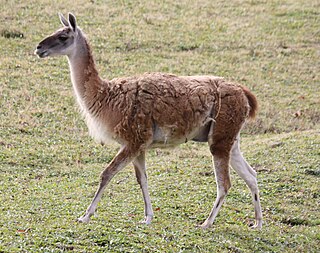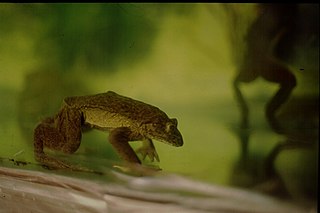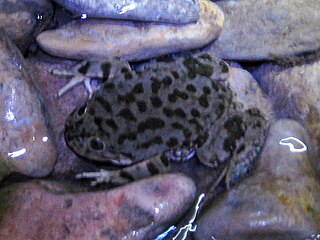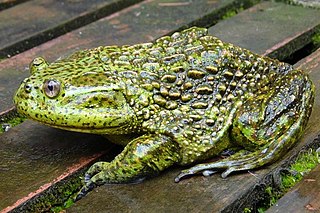
Telmatobius is a genus of frogs native to the Andean highlands in South America, where they are found in Ecuador, Peru, Bolivia, northwestern Argentina and northern Chile. It is the only genus in the family Telmatobiidae. Some sources recognize Batrachophrynus as a valid genus distinct from Telmatobius.

Lake Junin or Chinchaycocha is the largest lake entirely within Peruvian territory. Even though Lake Titicaca has a much larger area, its eastern half is located on Bolivian territory. Lake Junin is an important birdwatching destination in the country.

The fauna of the Andes, a mountain range in South America, is large and diverse. As well as a huge variety of flora, the Andes contain many different animal species.

Telmatobius macrostomus, also known as the Lake Junin (giant) frog or Andes smooth frog, is a very large and endangered species of frog in the family Telmatobiidae. This completely aquatic frog is endemic to lakes and associated waters at altitudes of 4,000–4,600 m (13,100–15,100 ft) in the Andes of Junín and Pasco in central Peru. It has been introduced to slow-moving parts of the upper Mantaro River, although it is unclear if this population still persists.
Telmatobius arequipensis is a species of frog in the family Telmatobiidae. It is endemic to southern Peru. It has an altitudinal range of 2,000–4,500 m (6,600–14,800 ft) asl. Two subspecies have been described, Telmatobius arequipensis arequipensis and Telmatobius arequipensis natatorVellard, 1955. Its common name is Chili water frog, after its type locality near Río Chili.

Telmatobius atahualpai is a species of frog in the family Telmatobiidae. It is endemic to the Cordillera Central of northern Peru and found in the San Martín and Amazonas Regions at 2,600–4,000 m (8,500–13,100 ft) asl.
Telmatobius colanensis is a species of frog in the family Telmatobiidae. It is endemic to northern Peru and only known from its type locality on the Cordillera Colán, near La Peca, Amazonas Region.
Telmatobius dankoi, also known as the Loa water frog, is a species of critically endangered aquatic frog in the family Telmatobiidae. It is endemic to Chile and is only known from its type locality near Calama, in the El Loa province. Only 14 individuals are known from captivity following the destruction of its habitat prior to 2019, so it may already be extinct in the wild. However, it is doubtfully distinct from Telmatobius halli and thus may not be a distinct species.
Telmatobius degener is a species of frog in the family Telmatobiidae. It is endemic to the La Libertad Region of Peru and only known from its type locality between Otuzco and Huamachuco, at 3,290 m (10,790 ft) asl. The type locality is in the very humid subalpine páramo. The frogs were active by day and found in pools and running water in a densely vegetated roadside marsh in an open pasture.
Telmatobius gigas is a critically endangered species of frog in the family Telmatobiidae. It is endemic to the Huayllamarca River at an altitude of about 4,000 metres (13,000 ft) in the Carangas Province in Bolivia. Its tiny range makes it highly vulnerable to pollution, and it may also be threatened by over-harvesting for medicinal use and the disease chytridiomycosis. As suggested by its scientific name, this is a very large species of frog with a snout-vent length of up to 10.9 centimetres (4.3 in) in females. In the genus Telmatobius, only two other threatened species, the Titicaca water frog and Lake Junin frog, are larger. T. gigas is very closely related to the smaller and more widespread T. marmoratus, and they might be conspecific.
Telmatobius halli is a species of frog in the family Telmatobiidae. It is endemic to northern Chile and only known from its type locality near Ollagüe. The specific name halli honors Frank Gregory Hall, an American specialist on the effects of high altitudes on human body and collector of the type series. Its common name is Hall's water frog.
Telmatobius ignavus is a species of frog in the family Telmatobiidae. It is endemic to the Cordillera de Huancabamba in the Department of Piura, Peru. Common name Piura water frog has been coined for it.

Telmatobius marmoratus, the marbled water frog, is a vulnerable species of frog in the family Telmatobiidae. The most widespread species in the genus, it is found in the Andean highlands of Bolivia, northern Chile and southern Peru. It may also occur in northwestern Argentina, but the taxonomic position of this population is unclear. This semiaquatic frog is found in and near streams, rivers, waterfalls, lakes and ponds.
Telmatobius pefauri is a species of frog in the family Telmatobiidae. It is endemic to extreme northern Chile. It was already feared that this species is extinct, but recent research has suggested that the species is extant at several localities in the Arica y Parinacota Region, albeit at low numbers. Furthermore, morphological and genetic data suggest that Telmatobius zapahuirensis is a synonym of Telmatobius pefauri. Common name Arico water frog has been coined for this species.
Telmatobius timens is a species of frogs in the family Telmatobiidae. It is found in western Bolivia and southeastern Peru at elevations of 3,350–3,750 m (10,990–12,300 ft) asl.
The Sehuencas water frog is a species of frog in the family Telmatobiidae. It is endemic to Bolivia. Its natural habitats are subtropical or tropical moist montane forest, rivers, and freshwater marshes. It is threatened by habitat loss. No individuals were encountered in the wild between 2008 and 2019.

Telmatobius culeus, commonly known as the Titicaca water frog or Lake Titicaca frog, is a medium-large to very large and endangered species of frog in the family Telmatobiidae. It is entirely aquatic and found only in the Lake Titicaca basin, including rivers that flow into it and smaller connected lakes like Arapa, Lagunillas and Saracocha, in the Andean highlands of Bolivia and Peru. In reference to its excessive amounts of skin, it has jokingly been referred to as the Titicaca scrotum (water) frog.

Calyptocephalella is a genus of frogs in the family Calyptocephalellidae. It is represented by a single living species, Calyptocephalella gayi, commonly known as the helmeted water toad, Chilean helmeted bull frog, or wide-mouthed toad. Additionally, there are a few extinct species that are only known from Late Cretaceous and Paleogene fossil remains from Patagonia in South America and the Antarctic Peninsula. The helmeted water toad living today is aquatic to semi-aquatic, and found in deep ponds and reservoirs in central Chile and possibly adjacent west-central Argentina.
Telmatobius espadai, also known as the Inquisivi water frog, is a species of frogs in the family Telmatobiidae, one of fourteen species of Telmatobius water frogs endemic to Bolivia.

Telmatobius ventriflavum, the Andean Water Frog, is a species of water frogs from the western Andes in Peru.










